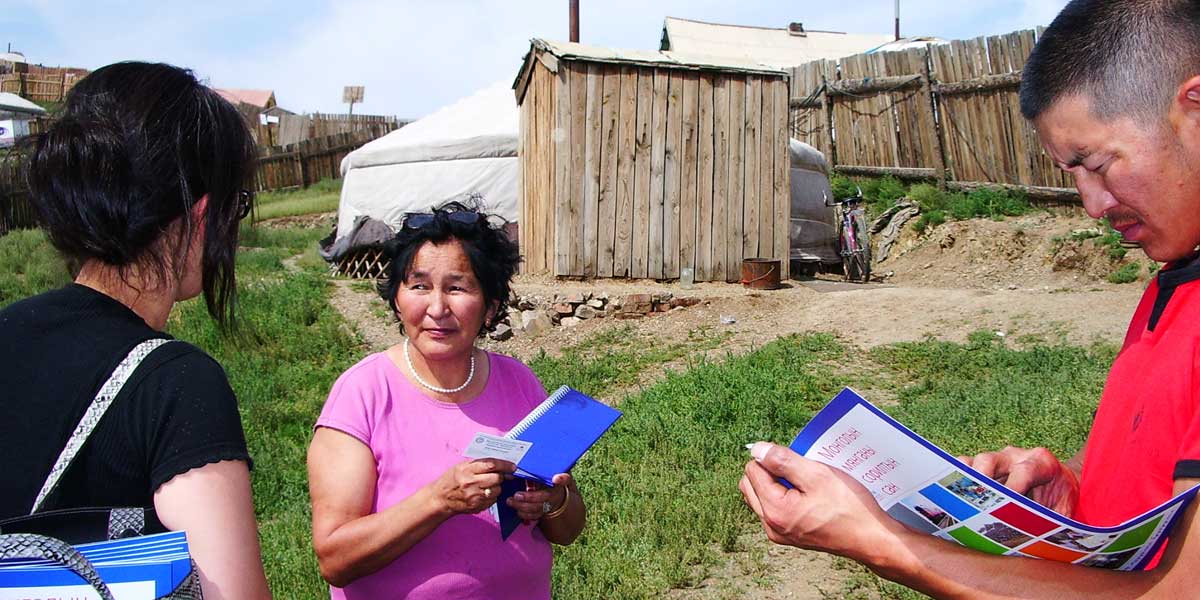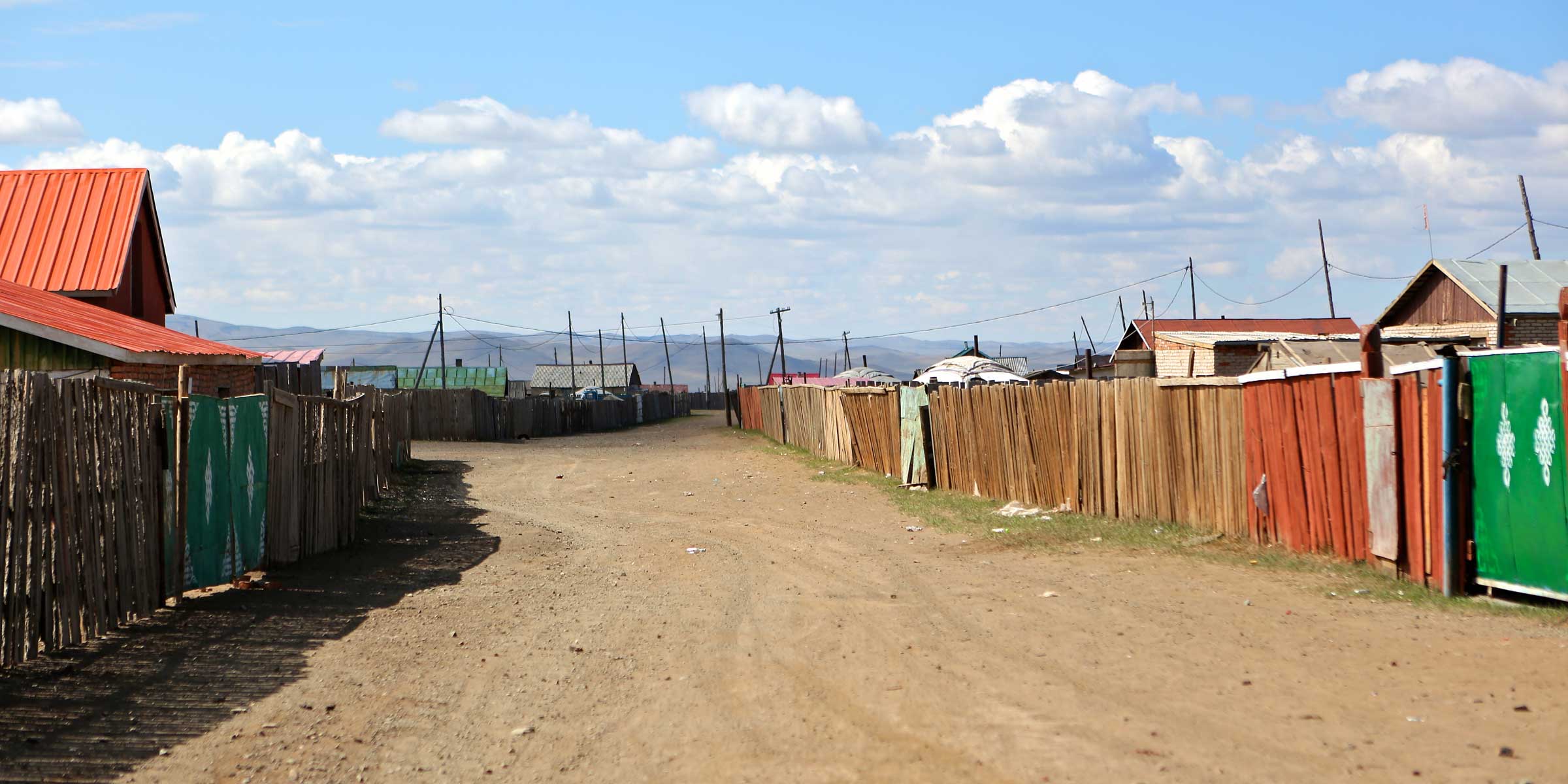Program Overview
MCC’s $268.9 million Mongolia Compact (2008-2013) funded the $28.5 million Property Rights Project, which included two activities in urban areas: a $1.7 million Privatization and Registration of Ger Area Land Plots (PR) Activity and a $13.6 million Land Registration System Activity. The PR Activity supported land registration of over 19,000 parcels and was based on the theory that land registration in informal settlements in the capital city of Ulaanbaatar and eight regional cities would increase tenure security, access to credit, investments, and land values.Evaluator Description
MCC commissioned Innovations for Poverty Action to conduct an independent impact evaluation of the Privatization and Registration of Ger Area Land Plots Activity. The evaluation was closed based on the interim results. Full report results and learning: https://data.mcc.gov/evaluations/index.php/catalog/93.
Key Findings
Land Registration
- The activity registered (titled) under 20,000 of the targeted 53,000 parcels due in part to self-registration.
- In 2013, 28 percent of land parcels in Ulaanbaatar program areas registered, but due to increased demand for land titles, 15 percent of parcels self-registered in control areas. It is not known whether this is a statistically significant difference.
- Since land registration did not increase in program areas relative to control areas as much as expected, further impact evaluation work was cancelled. An interim tracking survey was conducted to assess the feasibility of continuing the evaluation in just Ulaanbaatar. That data is presented below and shows non-impact data trends in control and program areas, which reflect potential benefits of a land title.
Tenure Security and Disputes
- Perceptions of tenure security improved over time in both control and program areas. Households with titled parcels felt substantially more secure than those without a title.
- The incidence of land disputes rose across control and program areas, but land disputes more than doubled in control areas compared to a 25 percent increase in program areas—a potential benefit from mapping all parcels.
- Households with land titles were less likely to experience conflict. In fact, land conflicts slightly decreased for those with titles but more than doubled for those without titles.
Access to Credit, Investment, and Land Values
- Land-based loans close to tripled in both control and treatment households. Households with land titles were more likely to successfully take out land-based loans.
- Over time, land-based investments approximately doubled in both program and control areas. Surprisingly, there was little difference in investment between titled and untitled parcels.
- Land values increased over time across program and control areas, but parcels in program areas experienced around double the increase. The land value of untitled parcels increased at a higher rate than titled parcels, though the average value of titled parcels was still higher.
Evaluation Questions
The evaluation questions included whether the activity led to:- 1 Improved feelings of tenure security
- 2 Reduced prevalence of land-related disputes
- 3 Increased use of land to access credit
- 4 Increased investment in the land or property
- 5 Increased land values
Detailed Findings
Land Registration
During the compact period, the demand for registration increased. This could have been due to a combination of the 2012 extension of the government of Mongolia’s 2008 policy providing free privatized land for each individual (rather than each household), and the Property Rights Project Registry System Activity, which opened new registry offices, streamlined land transaction procedures, and built awareness around the importance of land registration. Over 60 percent of survey households said they registered in order to gain a property in an individual’s name.At the same time, the program experienced implementation delays. Land privatization and registration activities in Darkhan and Erdenet took place March 2012–November 2012 and in Ulaanbaatar September 2012–September 2013. Almost a third of the land parcels in the program areas of Ulaanbaatar and 75 percent in Darkhan and Erdenet program areas had already self-registered. As such, by the end of the compact, the program mapped over 60,000 parcels but only registered 19,357 parcels. In addition, some households received a Governor’s Certificate, conferring private land rights, but were not registered.

The low achievement of targeted parcels titled by the program while control areas self-registered did not allow enough statistical power for an evaluation to identify a feasible minimum detectable effect on key outcomes. Changes between baseline and interim, as well as exploratory analysis of differences between titled and untitled groups, are presented below. These cannot be attributed to the activity.
Tenure Security and Disputes
Perception of tenure security increased overall with title being a driving factor. Based on official GASR tenure data, there was a 20 percentage point (p.p.) difference between households with and without land titles that felt secure in their tenure in both the baseline (67 percent vs 50 percent) and interim (86 percent vs 63 percent). The difference between titled (93 percent) and untitled households (52 percent) is even more distinct when using perceived tenure status from the household tracking survey.The expectation was that improved tenure status would reduce land-related conflicts. At baseline, there was little difference in conflicts between control (6 percent) and treatment households (7 percent); however, control households over time were about twice as likely to have experienced land disputes (13 percent) compared to baseline vs only a 2 p.p. increase for treatments (9 percent). Similarly, households with titles experienced a 1 p.p. decrease in conflicts compared to households without titles more than doubling in conflicts to 13 percent.

Access to Credit, Investment, and Land Values
The evaluation found loans increased to both control and treatment households, rising from 3 percent in baseline to 8 percent in interim. Households with land titles drove the increase, growing from 2 percent in baseline to 14 percent in interim while those without titles remained at 4 percent.Households increased investment in their land and/or property in both control and program areas and in both titled and untitled households. In program areas, households reported more than doubling their investment over time and came close to doubling investment among the control group. However, in control areas the increased investment was limited to households without titles, which is the opposite of expectations and hard to explain.
The average value of land per square meter for parcels of control and treatment households was similar for the baseline survey. By the interim survey, land value per square meter rose by 9,140 MNT in the program areas versus 4,450 MNT in the control areas. The significance level is unknown. Land parcels with titles had higher land values than unregistered land parcels (37,800 MNT per sq meter); however, surprisingly, the increase over time in land value for officially registered parcels (4,100 MNT per sq meter) was less than the land value increase for unregistered land parcels (9,720 MNT per sq meter).

MCC Learning
- In certain contexts, legal and institutional reforms improving land governance and administration may be sufficient to catalyze demand for formal land rights without the necessity of investments supporting systematic land titling.
- During project design, it is important to gain government agreement on which parcels will be registered, including those in the informal sphere. Once the compact is signed, it is difficult to get further government commitments.
- Capturing tenure status requires triangulation of data between administrative, survey, and project data. Due to outdated official records and lack of awareness by households on differences in land rights documentation, these different data sets often provide conflicting information on a parcel’s tenure status.
- If there is a lack of certainty on the exposure period necessary for key outcomes to develop, a small tracking survey is a low-cost alternative ahead of a full follow-up survey to understand effect levels and flag key factors to inform the household survey instrument.
Evaluation Methods
The planned impact evaluation relied on a randomized encouragement design in which eligible households in randomly chosen areas were offered assistance to obtain a land title. The evaluation sample covered three of the nine project cities where economic benefits of land registration and titling were expected to be strongest and where 75 percent of Mongolia’s population live—Ulaanbaatar, Erdenet, and Darkhan. The evaluator planned two data collection rounds: a baseline and endline; however, when it became clear at the end of land registration activities in September 2013 that the program would not achieve land registration targets, the evaluator and MCC agreed to 1) discontinue the evaluation in Darkhan and Erdenet, and 2) add an interim phone tracking survey for around 20 percent of the baseline sample in Ulaanbaatar to assess the feasibility of detecting program effect.
The evaluation relied on the following quantitative data:
- Baseline household survey on 5,816 urban land parcels (hashaas) in Ulaanbaatar (4,953), Darkhan, and Erdenet from December 2011–August 2012.
- Interim household tracking phone survey on 922 hashaas in Ulaanbaatar from March 2014–May 2014.
- Administrative data from GASR database as of July 2014 to verify the registration status of 871 hashaas in the tracking survey evaluation sample before and after 2013.
2020-002-2440


